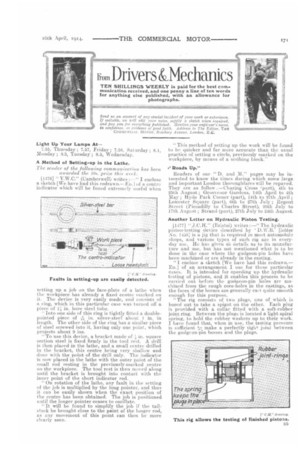Nom Drivers &Mechanics TEN SHILLINGS WEEKLY is paid for the best com
Page 23

If you've noticed an error in this article please click here to report it so we can fix it.
munication received, and one penny a line of ten words for anything else published, with an allowance for
photographs.
Send as an account of any sPecial incident of your work or experience. If suitable, we will edit yo6r votes, supply a sketch when required, and Inv you Jar everything published. Mention your employer's name, in confidence, as evidence of goad faith. Address to The Editor, THE COAINIERCIAL WYTOR, Rosebery Avenue, Landon, E.g.
Light Up Your Lamps At 7.55, Thursday ; 7.57, Friday ; 7.58, Saturday; 8.1, Monday ; 8.3, Tuesday ; 8.5, Wednesday.
A Method of Setting-up in the Lathe.
The sender of the following communical ;on has been awarded the Ws. prize
[1476] " (Camberwell) writes: I enclose
a sketch [We have had this redrawn.—Eu.] of a centre indicator which will be found extremely useful when
setting up a job on the face-plate of a lathe when the workpiecehas already a fixed centre marked on it. The device is very easily made, and consists of a ring, winch in this particular case was turned off a piece of V, in. bore steel tube.
"Into one side of this ring is tightly fitted a doublepointed piece of 1.46in. silver-steel about 1 in. in length. The other side of the ring has a similar piece of steel screwed into it, having only one point, which projects about 9 ins.
" To use this device, a bracket made of in. square section steel is fixed firmly in the tool rest. A drill is then placed in the lathe, and a small centre drilled in the bracket, this centre being very shallow and done with the point of the drill only. The indicator is now placed in the lathe with the outer point of the small rod resting in the previously-marked centre on the workpiece. The tool rest is then moved along until the bracket is brought into contact with the inner point of the short indicator red.
"On rotation of the lathe, any fault in the setting of the job is multiplied by the long pointer, and thus it can be easily shown when the exact position of the centre has been obtained. The job is positioned until the longer pointer ceases to oscillate.
It will be found to simplify the job if. the tailstock be brought close to the point of the longer rod, as any movement of this point can then be more clearly seen. " This method of setting up the work will be found to he quicker and far more accurate than the usual practice of setting a. circle, previously marked on the workpiece, by means of a scribing block."
"Roads Up."
Readers of our "D. and M." pages may be interested to know the times during which some large and important London thoroughfares will be repaved. They are as follow .—Charing Cross 'part), 4th to 25th August ; Grosvenor Gardens, 14th April to 4th May; Hyde Park Corner (part), 14th to '27th April ; Leicester Square (part), 6th to 27th July ; Regent Street (Piccadilly to Charles Street), 20th July to 17th August ; Strand (part), 27th July to 24th August.
Another Letter on Hydraulic Piston Testing.
[1477] "_3.C.H." (Bristol) writes:—' The hydraulic pistou-testing device described by ' D. WE.' [letter .Xo. 1158] is a jig that is required in most automobile shops, and various, types of such rig are in everyday use. He has giveu ifs details as to its manufacture and use, but has not mentioned what is to be done in the case where the gudgeon-pin holes have been machined or are already in the casting.
"I enclose a sketch [We have had this redrawn.— En.] of an arrangement I use for these particular cases_ It is intended for speeding up the hydraulic tasting of pistons, and it enables this process to be carried out before the gudgeon-pin holes are machined from the rough core-holes in the castings, as thefaces of the bosses are generally caq quite smooth enough for this purpose. " The rig consists of two plugs, one of wiyieli is bored out to take a spigot on tile other. Ea,ch plug is provided with a collar fitted with a soft-rubber joint ring. Between the plugs: is located a light.spiral spring, to hold the rubber washers up to their work. I have found that, when in use, the testing pressure
is sufficient make a perfectly tigiit joint between tie gudgeon-pin bosses and the plugs.
























